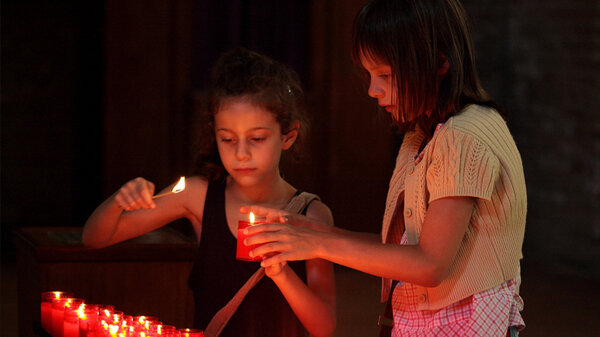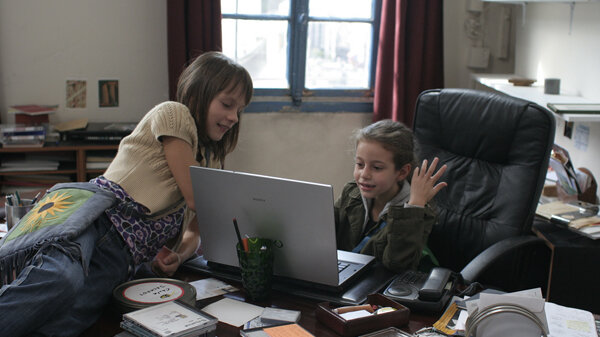In the sensitive cinema of Mia Hansen-Løve, characters engage with their surroundings as much as each other. Focusing in on one family of girls grappling with grief, the director’s sophomore feature embraces this lifeline. Serena Scateni explores this relationship.
“Places affect me and I need to get a hold of them. I feel like I understand their language,” says Camille, the protagonist of French director Mia Hansen-Løve’s third feature, Goodbye First Love, when her professor asks why she decided to study architecture. Torn between an overwhelming first love, which even after many years she finds impossible to forget, and a new, stable relationship with an older man, Camille roams through places. In her memories, these locations are attached to slices of life spent with her first boyfriend, now transformed into symbols of her emotional growth. Places encumbered by ghostly presences of the distant past are not just typical of Hansen-Løve’s third film – they are also at the core of her sophomore feature, Father of My Children, which, 10 years ago, won the Special Jury Prize in the Un Certain Regard section at Cannes Film Festival and sparked international recognition for its director.
Inspired by the life of late French producer Humbert Balsan, who championed female directors and Arab cinema and was about to produce Hansen-Løve’s directorial debut before taking his own life in 2005, Father of My Children is a melancholic yet gentle exploration of the intimacy and challenges within a family. Set against the backdrop of the French film industry, the film initially follows Gregoire Canvel (Louis-Do de Lancquesaing), a film producer whose company is on the brink of collapse due to long-standing debts, and surrenders to his depression and the looming menace of a financial and professional defeat. After burning all of his outstanding bills, it is in a secluded and unadorned street that he shoots himself. Gregoire leaves behind a wife, Sylvia (Chiara Caselli), and three daughters, who must now deal with unexpected, overpowering grief while navigating life and a family secret.
As much as Father of My Children is a family drama – we see the same thread weaving through Hansen-Løve’s debut, laying bare a sophisticated veneer of turbulent forces keeping a father from his daughter – it’s also a film exploring the magnetic allure of known places resurfacing from our past, and of the ones we visit for the first time but which spark familiar emotions. Like the country house Camille and her boyfriend retreat to near the beginning of Goodbye First Love – then recurring in the film to signal different stages in the young woman’s life after love – every weekend, the Canvels escape Paris and find solace within their luxurious home in the countryside. Here we see the family together for the first time, and the audience is embraced by the loving relationship between this father and his daughters, who show him their little garden and put on a play in which they tenderly mock his incessant work calls. The house then becomes a playground, a safe space where Gregoire can unwind and attempt to place his working life on hold.
The chapel within walking distance from the family’s house holds a similar bonding power. “Girls, this is not an ordinary chapel,” Gregoire explains, approaching the site drenched in sunlight, “It’s a Templar chapel”. Immediately after, he’s flooded with questions about Templars and Crusaders to which he patiently offers his knowledge in return. While exploring, Sylvia and the girls listen to these tales from an ancient past, which become part of their own personal stories affixing their family’s connection to the site. Later on, after Gregoire’s death, Hansen-Løve brings the family back to that same place. At dusk, they lay flowers in a recess of the wall. In silence, they hold each other before leaving the chapel, now a graveyard for the memory of their father. One final time, the audience is shown its ivory walls. Fleeting as a painful thought; seconds later a lawyer declares the only viable option for Gregoire’s film company is to be liquidated. Quick shots of the country house, the nearby river, and the chapel follow one another: no score accompanies them; there’s only the silence of the last failed attempt at keeping a memory afloat. The last tangible stronghold of Gregoire’s feeble empire is eventually gone under the attack of the inevitable, financial reasoning.
Another emotionally-charged space is Gregoire’s company office, Moon Films, nested within an elegant apartment building facing a bustling Parisian street. The walls are decorated with posters of successful films, while documents are scattered everywhere; folders, and promising new scripts waiting for Gregoire to unearth. Many times we are allowed to see into Gregoire’s personal office, to feel the pulse of the company’s situation. Living off Gregoire’s charm, it is a collapsing utopia, a stimulating place where ideas are meant to blossom, not wither. Ultimately, it’s a space decidedly separate from the familial sphere. When the time comes for these two worlds to overlap, the emotional recoil Sylvia has to endure is almost unbearable. At night, after Gregoire’s death, surrounded by overdue invoices, she browses aimlessly through his notebook, blaming herself for her husband’s suicide. Days later, when his three daughters finally visit, the office is almost no more.
With the liquidator in the next room, the younger girls bring their curiosity into the empty shell of Gregoire’s space: Billie sits on her father’s chair feigning to take a phone call while checking something on his laptop; Valentine browses through the bookshelves until she finds some outtakes she wants to take home. Infusing the room with their childlike energy, they wash away the negative connotations attached to the place. While Clemence and Valentine finally converge to Gregoire’s desk, Billie finds comfort in her mother’s embrace. “Moon Films won’t exist anymore?” she asks with candour. No, clearly, but Gregoire’s soul will live on through his films, and although this reply feels a bit banal it encapsulates the ultimate wish of every person working in artistic sectors. We struggle and we create always wanting to leave a mark, an ephemeral trace of our passage on Earth. In the disappearing space of their father’s office, these three young girls and their mother eventually come together as a newfound family. Things may be transient, but they will be standing as proof of their father’s legacy.
Among the spaces that contribute to this mourning map of absence, there’s one that encompasses them all: Paris. Acting as both an extension to Gregoire’s office – many times we follow him through various wanderings from one frustrating meeting to another – and a maze for Clemence, the eldest daughter, in which she can lose herself while processing her grief. A stroll along the Seine on a day of clear sky and mild weather leads a pensive Clemence to a cinema where one of the arthouse films her father produced is showing. After the film, a brief chat with an aspiring filmmaker offers her a moment to leave her sorrows aside. One of the most complex characters in the film, Clemence is hardly vocal about her turmoil. She suffers, but she keeps it to herself, so she ruminates and – perhaps unconsciously – looks for her father’s presence everywhere. Balancing a self-inflicted pain in the constant reminder of her father’s death and her vibrant desire to meander and own the city as much as her father used to, Clemence connects with Paris and wishes to thrive in it. Yet all these places – the chapel, the office, but also the city and the country house where the family shared moments of intimacy – are destined to fade into memory and with time be shaped into cherished tokens of a too brief a life together. “Que sera, sera / Whatever will be, will be / The future not ours to see / Que sera, sera” finally sings Doris Day while a taxi braves the streets of Paris, taking away the Canvels – while tears streak Clemence’s cheeks.
Serena Scateni (@29s____) is an Edinburgh-based freelance film journalist, published on Little White Lies, MUBI Notebook, NANG Magazine, The Skinny. She's a lover of East Asian cinema and all things Japanese, on which she enjoys writing whenever given the chance. She's also interested in queer cinema and female directed films. Don't ask her what her favourite film is - she just doesn't want to know.
Our MIA HANSEN-LØVE t-shirt is available to purchase here. Proceeds go towards paying our writers and supporting female-led film projects.



